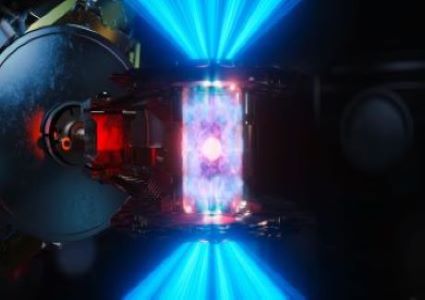Pledging
These are the original issues in this subcategory

You May Pledge Your Support For This Issue With A Monetary
Donation And By Writing A Letter To Your Representatives
- SMART GRID
- ENERGY STORAGE
- FUSION ENERGY

Nuclear Fusion reactions power the Sun and other stars. Many believe the “holy grail” of clean energy lies in fusion energy. Fusion works by pressing hydrogen atoms into each other with such force that they combine into helium, releasing enormous amounts of energy and heat. Unlike nuclear fission reactions, in which the nucleus of an atom splits into two or more smaller nuclei, fusion creates no radioactive waste. The heat produced by a thermonuclear fusion reactor could be used by conventional turbine generators to produce electricity without any pollution or waste whatsoever. Fusion reactors employ powerful magnets or lasers to greatly compress hydrogen particles. A 2022 breakthrough experiment in fusion technology has, for the first time, produced more energy than consumed by the reactor. This crossed the threshold that scientists call ignition, the dividing line where the energy generated by fusion equals the energy of the incoming lasers that start the reaction. In a brief moment lasting less than 100 trillionths of a second, 2.05 megajoules of energy — roughly the equivalent of a pound of TNT — bombarded a hydrogen pellet. Out flowed a flood of neutron particles — the product of fusion — which carried about 3 megajoules of energy, a factor of 1.5 in energy gain. Scientists in South Korea have recently set a record of 48 seconds for the length of time they sustained temperatures of 100 million degrees Celsius — seven times hotter than the sun’s core. Their ultimate aim is to be able to sustain these plasma temperatures for 300 seconds by 2026, in order to be able to scale up fusion operations.
Our government has funded fusion science research since the 1950s and today invests about $700 million per year into fusion research. The Department of Energy recently announced that $50 million will go toward private nuclear fusion companies in public-private partnerships, saying “This money signifies that the U.S. government is getting serious about building a fusion program that will have commercial significance on an accelerated timeframe.” Even so, it is estimated that a viable commercial fusion power plant remains at least several decades away. Advocates say a few million dollars is not a sufficient level of funding for fusion technology if it is to solve our energy problems before it’s too late.
Pending Legislation: H.R.5244 - Fusion Energy Act
Sponsor: Rep. Lori Trahan (MA)
Status: Subcommittee on Energy, Climate and Grid Security (Energy and Commerce)
Chair: Rep. Jeff Duncan (SC)
Tweet
Our government has funded fusion science research since the 1950s and today invests about $700 million per year into fusion research. The Department of Energy recently announced that $50 million will go toward private nuclear fusion companies in public-private partnerships, saying “This money signifies that the U.S. government is getting serious about building a fusion program that will have commercial significance on an accelerated timeframe.” Even so, it is estimated that a viable commercial fusion power plant remains at least several decades away. Advocates say a few million dollars is not a sufficient level of funding for fusion technology if it is to solve our energy problems before it’s too late.
Pending Legislation: H.R.5244 - Fusion Energy Act
Sponsor: Rep. Lori Trahan (MA)
Status: Subcommittee on Energy, Climate and Grid Security (Energy and Commerce)
Chair: Rep. Jeff Duncan (SC)
Tweet
- I oppose reforming current fusion energy policy and wish to donate resources to the campaign committee of Speaker Mike Johnson (LA).
- I support amending the Atomic Energy Act of 1954 to include fusion energy machines such as a particle accelerator that are capable of: 1.) Transforming atomic nuclei, through fusion processes, into other elements. 2.) Directly capturing and using the resultant products, including particles, heat, and other electromagnetic radiation, for a commercial or industrial purpose. And wish to donate resources to the campaign committee of Rep. Jeff Duncan (SC) and/or to an advocate group currently working with this issue.
- I support amending the Atomic Energy Act of 1954 to include fusion energy machines such as a particle accelerator that are capable of:
1.) Transforming atomic nuclei, through fusion processes, into other elements.
2.) Directly capturing and using the resultant products, including particles, heat, and other electromagnetic radiation, for a commercial or industrial purpose.
And wish to donate resources to the campaign committee of Rep. Jeff Duncan (SC) and/or to an advocate group currently working with this issue.
Donation And By Writing A Letter To Your Representatives
Please login to pledge
Pledge Period - Opening Date
November 4, 2024
Pledge Period - Closing Date
November 10, 2024
Trustee Election - Begins
November 11, 2024
Suggest a worthy trustee for consideration before Day 16 of this presentation cycle. (Maximum 60 Characters)